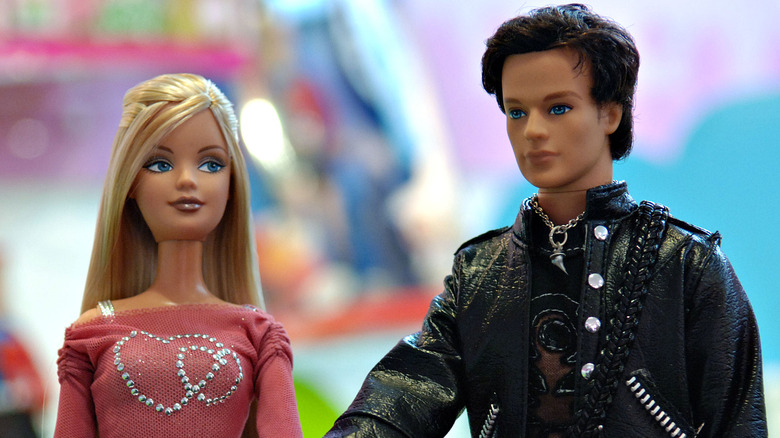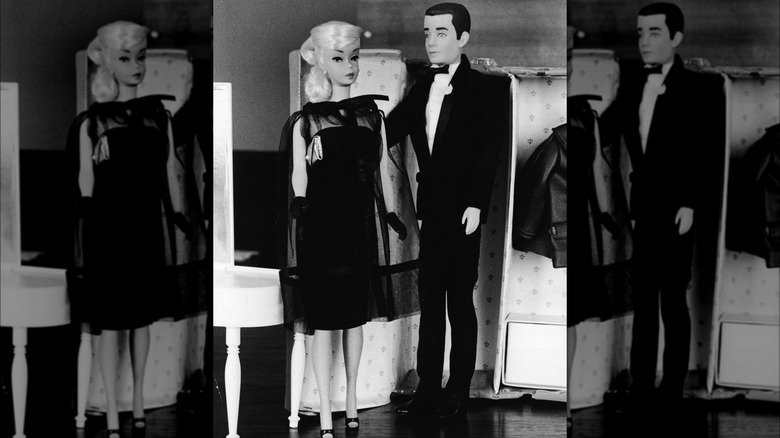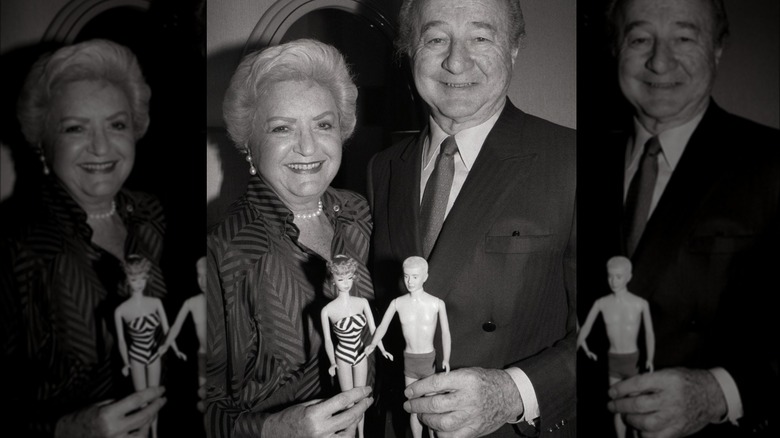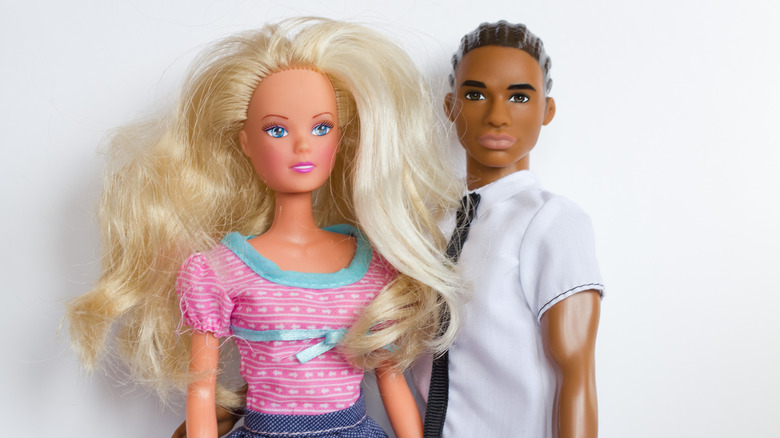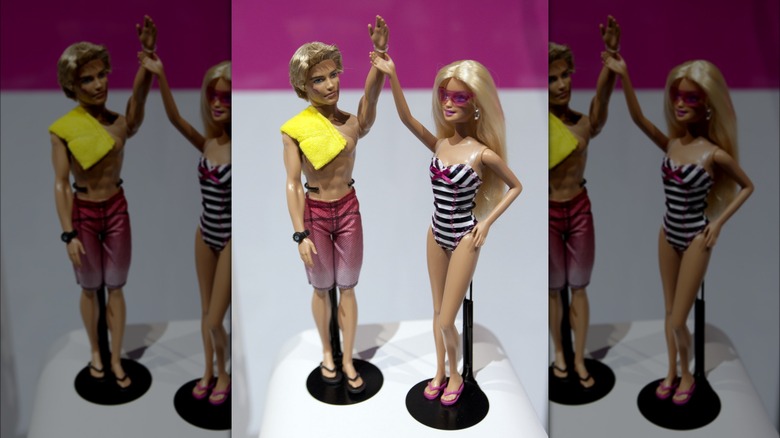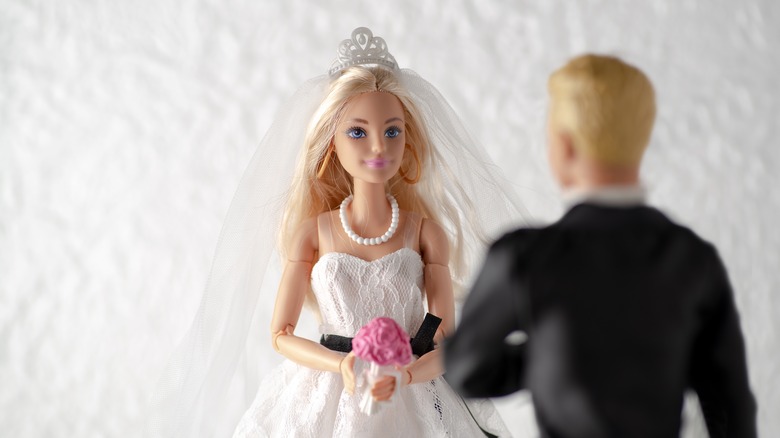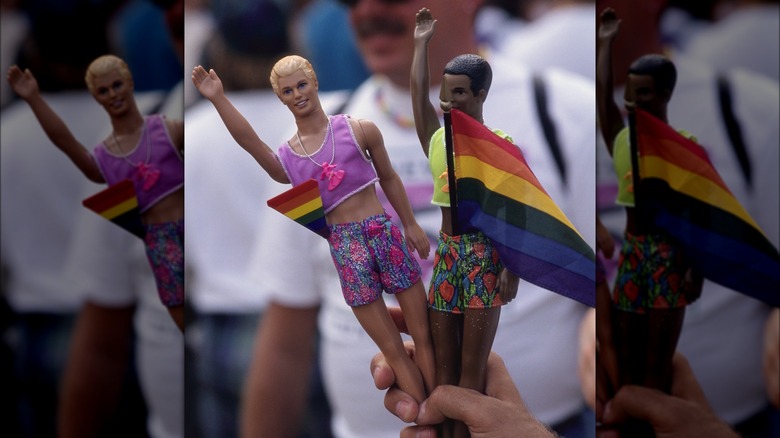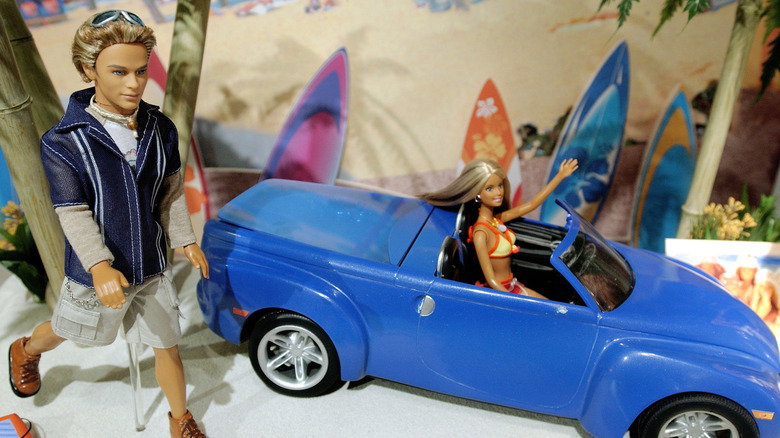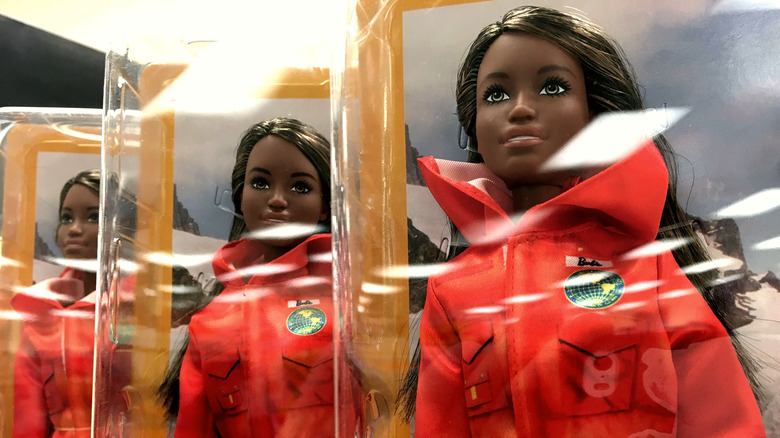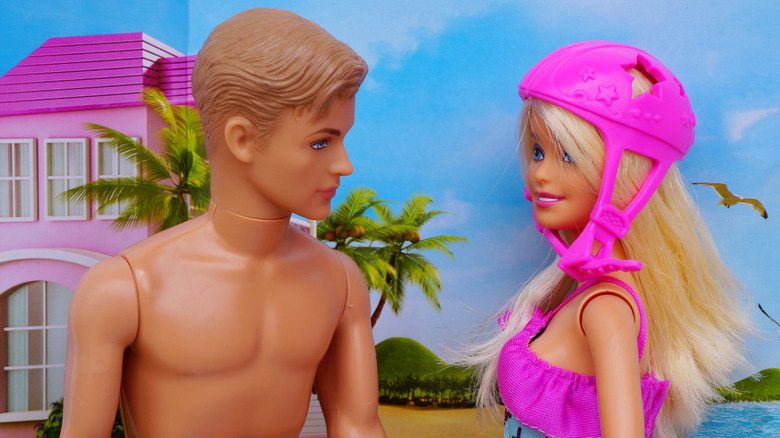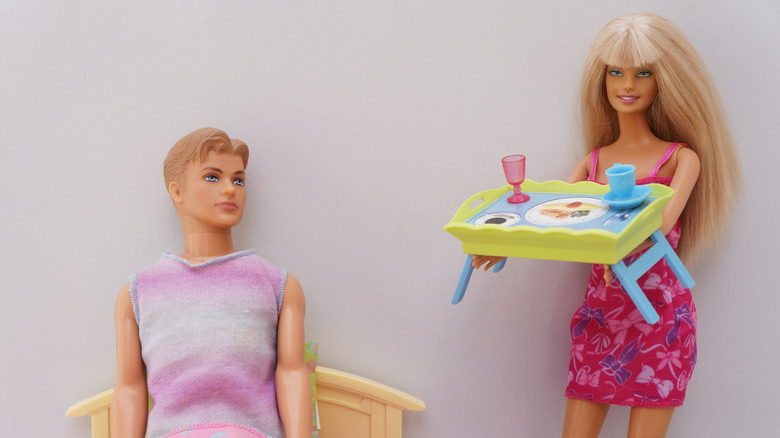Weird Things Everyone Ignores About Barbie And Ken's Relationship
Thanks to inventor and Mattel co-founder Ruth Handler, Barbie was born with a monumental purpose. Handler's vision for Barbie was beyond your average plaything — she wanted the doll to symbolize girl power and independence. "My whole philosophy of Barbie was that through the doll, the little girl could be anything she wanted to be," the toymaker wrote in her autobiography (via The New York Times). "Barbie always represented the fact that a woman has choices." Since the late 1950s, Barbie has shattered gender roles and encouraged children to dream big. But there's one detail about Barbie that Handler didn't bargain for. While the prototypical Barbie was ready to take on the world solo, consumers wanted something more traditional. Thus, influenced by public pressure, Mattel created a boyfriend for Barbie.
Barbie's purported lover, Ken, has become an icon in his own right. With his dashing good looks and infinite charms, Ken is the ultimate dream guy doll. And as one would expect of a fashion doll union, Barbie and Ken are a top-tier power couple — gorgeous, glamorous, and without a single flaw. At least, that's how things appear through Barbie's stylish rose-colored glasses. But a fairly curious picture emerges when you wade into the details of Barbie and Ken's relationship. With Barbie mania fully underway thanks to Greta Gerwig's blockbuster "Barbie" film, it's a perfect time to spotlight the intriguing, if not flat-out weird, things everyone ignores about Barbie and Ken's relationship.
Barbie and Ken were named after a real-life brother and sister
Barbie was the first of her kind when she debuted in 1959. Before Barbie, girls' toys revolved around themes of domestic labor, and dolls typically took the form of babies. Although homemaking is a valid ambition, Barbie's creator, Ruth Handler, felt it was time for a new type of doll. Thus, Ruth rejected the customary baby doll and created a full-fledged woman doll. Everything about Barbie was cutting-edge, from her wardrobe to her career as a fashion model.
Ruth also noticed that baby dolls had fallen out of favor with her daughter, Barbara Handler, who was more interested in playing with paper fashion dolls. The observation helped validate Ruth's revolutionary idea. She named the iconic doll "Barbie" in Barbara's honor. As Ruth once told the Los Angeles Times, "If it hadn't been for Barbie, I would have never come up with the idea for the doll."
When Ken came along in 1961, he followed a similar trajectory. Ruth created the hunky doll as Barbie's perfect match: her Prince Charming, unconditional supporter, and enthusiastic wearer of flawlessly coordinated couple's outfits. When choosing a moniker for the doll, Ruth kept with tradition by naming him after her son — and Barbie's brother — Kenneth Handler. So, although Barbie and Ken are known as the world's most famous toy couple, it may very well be more accurate to describe them as brother and sister.
Ken's creation was a response to consumer outrage
Barbie may have been conceived in the image of a modern, self-empowered woman — but some consumers weren't impressed with her single status. As far as the masses were concerned, Barbie could have all the clothing and shoes in the world, but she was still missing the ultimate accessory: a boyfriend. In her autobiography, Barbie creator Ruth Handler revealed that fans sent numerous letters demanding a suitor for Barbie. The uproar was too loud to be ignored, so Handler delivered. As "Barbie" director Greta Gerwig said in Vogue in 2023, "Ken was invented after Barbie, to burnish Barbie's position in our eyes and in the world. That kind of creation myth is the opposite of the creation myth in Genesis."
In her book "Barbie: the Unauthorised Biography of a Real Doll," author MG Lord explained that Ken was a hefty risk for the toy company: "Mattel, in fact, never wanted to produce Ken; male figure dolls had traditionally been losers in the marketplace." Evidently, Ken proved to be less of a loser than those male figure dolls who came before him.
In 1961, Barbie received her dream guy: a fit, immaculately-groomed stud in tiny red swim trunks. His full name was Kenneth Sean Carson, and he stood half an inch taller than Barbie. And from that moment on, he's been a fixture of the Barbie universe.
There are conflicting versions of Barbie and Ken's meet-cute
Every couple has an origin story, but Barbie and Ken's mythology has an air of mystery to it. Over the years, Mattel has offered at least two different versions of how Barbie met Ken. The first story came from Ken's debut commercial, which aired in 1961. The ad shows Barbie decked out in an elegant, fur-trimmed ballgown. "It all started at the dance," a narrator tells us, revealing that Barbie "felt that this was to be a special night." Then, the glamorous doll turns and sees Ken for the first time. The vintage commercial was our first introduction to Barbie's boyfriend and his "perfectly tailored clothes of unmatched quality," as the voiceover proclaims.
The second version of Barbie and Ken lore comes directly from Mattel, and it is a fairly meta theory. According to Barbie Media, the fashion dolls actually connected while filming their first commercial together. Regardless of how their meet-cute went down, two facts remain consistent: they've been an item since 1961, and it was love at first sight. The rest, as we know, is history.
Contrary to popular belief, they have not consummated the relationship
Most of us can attest to playing with Barbie dolls in strange ways during childhood. Whether you chopped off Barbie's hair, covered her in crayon marks, or yanked off her arm, you're not alone. The same goes for using Barbie and Ken to act out adult-themed activities — it's standard behavior amongst Barbie owners. Nevertheless, the reality is that Barbie and Ken have never actually had sex, as evidenced by their complete lack of sexual anatomy.
If you've ever wondered about how Ken's awkwardly smooth crotch came to be, trust us, you're not the only one. In fact, during his development, Ken's groin was a significant topic of debate at Mattel. Ken's creator, Ruth Handler, envisioned Barbie's boyfriend with a penis — or at least a "little bump" to suggest the presence of one. But that was a step too far in the eyes of Mattel executives. Handler told BBC in 1997, "It was a conscious decision to make the Ken doll without genitals. That was a discussion between the designers and me, in which I lost." Ultimately, Handler's persistence paid off, and Ken "did get a little bump as time went on."
In Greta Gerwig's "Barbie," Barbie and Ken don't know what sex is, which suggests that the deed doesn't exist in Barbie Land. As Gerwig told Vogue, "You feel that there's something there, which is part of the allure."
Contrary to popular belief, they never married or had children
After Ken was created in response to consumer demands, there were more attempts to influence Barbie's life in plastic — namely, fans wanted her to get married and have children. After all, this was the expected trajectory for most women at the time, as MG Lord detailed in the book "Barbie: the Unauthorised Biography of a Real Doll." "The reason for their demand was obvious," Lord wrote. "Barbie taught girls what was expected of women and a woman in the fifties would have been a failure without a male consort."
While many fans have assumed otherwise, Barbie and Ken actually never officially made it down the aisle. This was a deliberate choice by Handler, as Barbie was meant to be a symbol of choice for little girls. Through Barbie, Handler wanted to convey that being a homemaker was just one of many options available to young women. That said, Mattel found ways to meet consumers in the middle regarding their wishes for Barbie. Rather than give her a baby, the toymakers gave her a gaggle of siblings — seven in total. Mattel also developed several babysitter Barbies, as well as a pediatrician Barbie.
Instead of having Barbie get pregnant, Mattel passed the buck to her friend, Midge. A pregnant Midge doll was released in 2002, and she featured a removable pregnancy belly that concealed a tiny infant underneath. Midge landed Mattel in immediate hot water with consumers, and she was discontinued within the year.
Could Ken be Barbie's gay best friend, not her beau?
In addition to the question about whether or not they're actually siblings, there's yet another theory that suggests Barbie and Ken's relationship may not be a romantic one. Many feel that Ken's creators were wrong to characterize him as Barbie's boyfriend — because he's actually her gay best friend. Of course, Ken being gay is not weird in and of itself, but it would be a notable departure from the extremely heteronormative relationship history assigned to the dolls.
The Daily Beast points to Ken's queer-coded storyline in the film "Toy Story 3," which presents him as Barbie's fashion-obsessed platonic companion. However, the most compelling evidence comes from Ken himself — specifically from Magic Earring Ken, who is widely considered a queer icon. The doll was a glorious display of '90s queer counter-culture, complete with a mesh shirt, frosted hair, and a ring-like necklace that, to many, resembled a certain sex toy. Mattel discontinued the controversial doll six months after his 1993 debut; his legacy remains, and he is still one of the most popular Kens ever.
When Margot Robbie spoke with Attitude in 2023, the "Barbie" star offered her thoughts on Ken's sexuality. "[T]hey are all dolls," the actor explained, "So, they don't actually have sexual orientations because they don't have any reproductive organs, we figured." Robbie added that Barbie Land is a place for everyone, including queer icons — and yes, Magic Earring Ken does appear in the "Barbie" movie.
Ken and Barbie had a dramatic breakup
File this one under "strange marketing schemes that actually worked." In 2004, Barbie and Ken called off their legendary romance, proving that even plastic hearts can break. Mattel's Vice President of Marketing delivered the news. "Like other celebrity couples, their Hollywood romance has come to an end," the executive said in a statement, per Time. Another bombshell rocked the Barbieverse when Mattel revealed that Barbie had moved on and was dating Blaine (pictured above), an Australian doll with a passion for boogie boarding. However, by 2006, Blaine was discontinued, and Ken returned with an updated look. The designer behind Ken's new appearance, Phillip Bloc, told news outlets that "Ken has revamped his life—mind, body, and soul" in an effort to win back his lady, per CNN.
Lisa McKnight, an executive of Mattel, told Entertainment Weekly that the breakup triggered a massive backlash from the Barbie community. "We got a lot of formal petitions from brand fans, Barbie fan groups, asking for them to get back together," McKnight explained. So there's a lot of passion there. They really are the sort of ultimate 'it' couple. So everyone's rooting for them to get back together." McKnight revealed that the dolls ultimately realized they were endgame and rekindled their romance in 2011. Barbie even made things official by changing her Facebook status to "In a relationship."
Barbie reaches for the stars, Ken reaches for the beach
No dream is too big for Barbie. After all, she's the doll who emerged as a trailblazing tycoon during an era where women had fewer economic opportunities — her whole brand is about going against the grain — and she takes that role very seriously. Over the years, Barbie has racked up an impressive resume. According to Mattel, the tenacious toy has held over 200 jobs, including astronaut, surgeon, veterinarian, and many more. Ken holds some impressive job titles, too — but he has one distinct specialty: beach bum. According to Time, that's the official job title of at least a dozen different iterations of the Ken doll.
On top of her ambitious career moves, Barbie owns numerous cars, campers, and boats — plus her sprawling Dreamhouse. Barbie has always been a self-sufficient queen, which explains why her relationship with Ken is a mediocre subplot in an otherwise riveting story. As "Barbie" star Ryan Gosling sees it, Ken struggles with living in Barbie's bountiful shadow. "Ken's got no money, he's got no job, he's got no car, he's got no house. He's going through some stuff," Gosling told Entertainment Tonight (via CNN).
He may not be the breadwinner, but Ken has found other ways to pull his weight in the relationship. Barbie Media has dubbed him "arm candy," "Prince Charming," and "the guy-in-waiting." He's always willing to sidestep the spotlight and give Barbie infinite room to shine — and we love that about him.
Ken has not always kept up with Barbie
We've seen Barbie's hair take on all different shapes, lengths, colors, textures, and styles; her makeup is always au courant. Ken's appearance, on the other hand, underwent a limited amount of changes over the course of the first few decades of his existence. Sure, his hair went from flocked to plastic to synthetic, but beyond that? Reworking Ken's overall look was not exactly the top priority. As former Mattel VP Michael Shore told GQ, "Ken was really viewed as more of an accessory in Barbie's world, to support the narrative of whatever was happening with the girls."
In 2017, the Ken line got what The Guardian called its "biggest aesthetic update since 1961." "Evolving Ken was a natural evolution for the brand and allows girls to further personalize the role they want him to play in Barbie's world," Mattel exec Lisa McKnight said in a statement at the time, per The Dallas Morning News. This makeover included new body types, new skin tones, and nine new hairstyles. In 2021, Mattel introduced a Ken who uses a wheelchair. The following year, a Ken doll with vitiligo was unveiled.
As Barbie continues to be more inclusive, Ken is now following in her footsteps. According to senior Barbie designer Robert Best, there's much more Ken-novation on the way. "People want to see themselves in product, which is why being inclusive and diverse is so important," he told USA Today, adding that Ken is "definitely continuing to evolve and grow."
Their relationship has been used to push problematic ideas about gender
As the creator of the Barbieverse, Ruth Handler understood the unique language between a Barbie and her owner. "It gives a little girl the ability to dream about her future," Handler told Lilith in 1994. "A girl can interpret the adult world around her with this doll as a prop." Unfortunately, the adult world can be harsh, and Barbie has occasionally been used to communicate some troubling messages about gender.
For example, in 1981, Barbie starred in a commercial that portrayed a toxic relationship dynamic between her and Ken. The ad featured two little girls playing with Magic Curl Barbie, a doll with voluptuous curls that could be straightened using a special styling product. One girl says Barbie should change her hair because "Ken likes it straighter." When her playmate announces that Barbie prefers her hair to be curly, the other responds that Barbie had better "fix Ken a sandwich" — big yikes. Although it wasn't the first (or last) controversial Barbie moment, it was a definite setback for Barbie's feminist image.
Nobody said it was easy being a feminist icon, and Barbie has undoubtedly been through the wringer — especially regarding her relationship with Ken. Nevertheless, she's continued to lead the charge of making children feel empowered, represented, and valued — and if you ask us, that's a pretty remarkable legacy.
